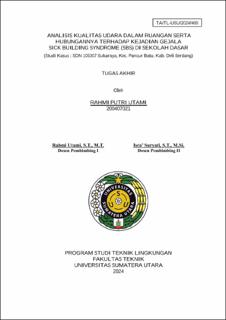Analisis Kualitas Udara dalam Ruangan serta Hubungannya terhadap Kejadian Gejala Sick Building Syndrome (SBS) di Sekolah Dasar (Studi Kasus SDN 105307 Sukaraya, Kec. Pancur Batu, Kab. Deli Serdang)
Analysis of Indoor Air Quality and Its Relationship to the Incidence of Sick Building Syndrome (SBS) in Elementary School (Case Study: SDN 105307 Sukaraya, Pancur Batu District, Deli Serdang Regency)

Date
2024Author
Utami, Rahmi Putri
Advisor(s)
Utami, Rahmi
Suryati, Isra'
Metadata
Show full item recordAbstract
The quality of indoor air has become a very important concern as it has the potential to affect the health and comfort of occupants. SDN 105307 Sukaraya is a school located on the edge of a highway, which may lead to a decrease in indoor air quality and can cause complaints of Sick Building Syndrome (SBS) symptoms. This study aims to analyze the level of indoor air quality (temperature, humidity, lighting, ventilation rate, PM2.5, PM10, CO, and CO2), identify Sick Building Syndrome (SBS) symptoms, and analyze the relationship between indoor air quality and the occurrence of Sick Building Syndrome (SBS) symptoms. This research uses a Cross-Sectional design and Chi-Square statistical test method. SBS respondent data were collected using a questionnaire with a total of 83 respondents. The analysis results show that the average parameters of temperature, lighting, ventilation rate, PM10, CO gas, and CO2 in the three classrooms meet the quality standards, while humidity and PM2.5 parameters do not meet the quality standards. The most commonly reported SBS symptoms are sneezing and flu, followed by fatigue and lethargy. The Chi-Square test analysis results indicate a significant relationship between temperature and the occurrence of Sick Building Syndrome (SBS) symptoms with a p-value of 0.049. There is a significant relationship between humidity and the occurrence of Sick Building Syndrome (SBS) symptoms with a p-value of 0.043. There is a significant relationship between CO2 gas and the occurrence of Sick Building Syndrome (SBS) symptoms with a p-value of 0.013. However, there is no significant relationship between lighting, ventilation rate, PM2.5, PM10, and CO gas and the occurrence of Sick Building Syndrome (SBS) symptoms as the p-value is > 0.05. However, based on the analysis of correlation coefficient (R) and determination coefficient (R2), the concentration of PM2.5 has a very strong relationship with the occurrence of complaints of sneezing, flu, and cough most frequently with a value of R = 0.92 and R2 = 85%. The concentration of PM10 has a very strong correlation coefficient with the occurrence of complaints of fatigue and lethargy with a value of R = 0.99 and R2 = 99%
Collections
- Undergraduate Theses [404]
